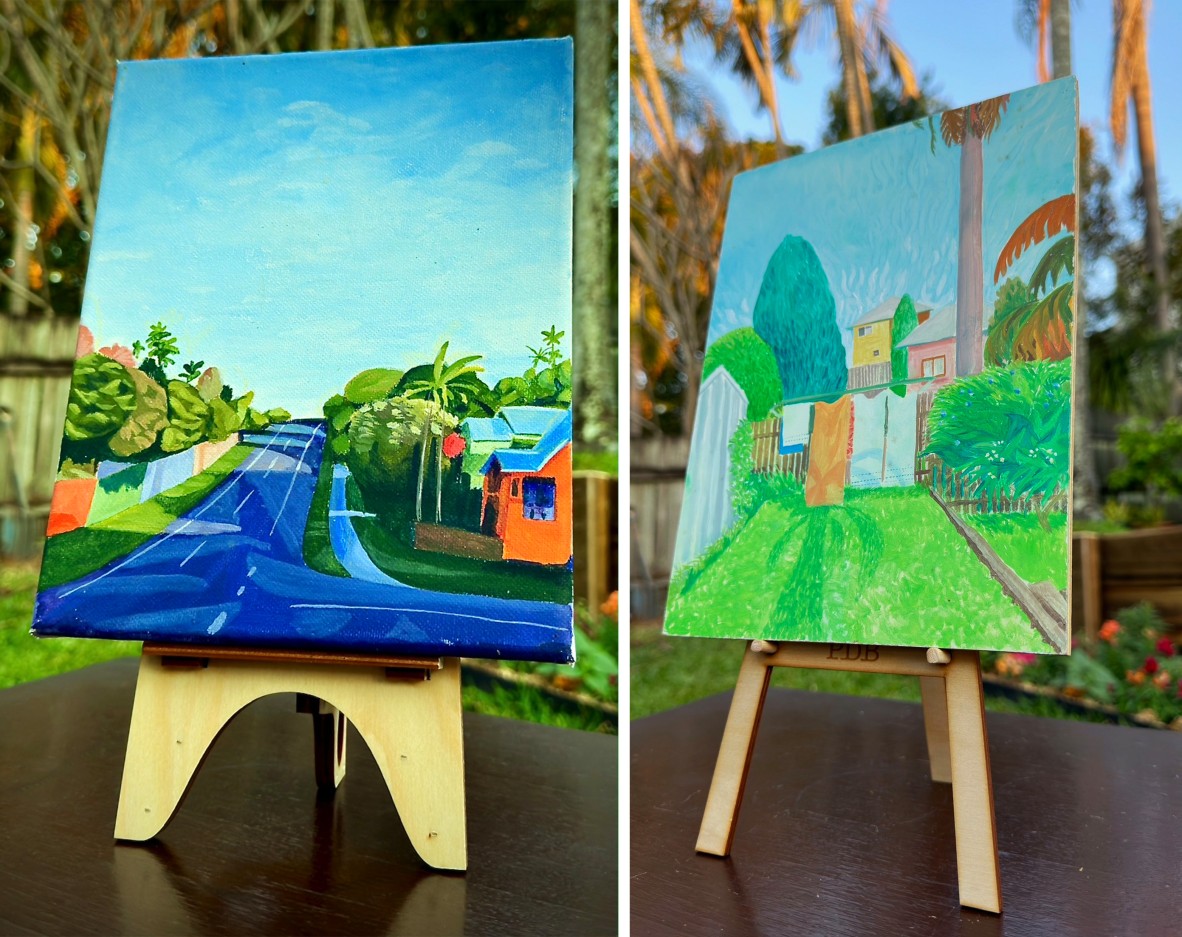#MadeToday Profile: Mini Easels with Tom
By Ellie Dumigan and Tom. | 25 September 2024
Why buy mini easels when you can craft your own out of acrylic and plywood at The Edge using our high-tech laser cutter (after an induction, of course). That’s exactly what Tom did for his artist friend, Paul Best, who needed mini easels for his small paintings. And what better way to spend his retirement than being creative, learning new skills, and helping a friend.
We sat down with Tom to explore not just this project but also the inspiration behind it and his exciting plans for future creative endeavours:

Mini easels made with the Laser cutter out of acrylic.
I’ve had a life-long interest in, and admiration for, well-built objects, be they large or small. I appreciate both the form and function of objects as well as the skill involved in achieving the physical delivery of the (intellectual) design concept.
Needless to say, throughout my life, I have enjoyed building “things” which have ranged from simple woodwork to electronics. Predictably, I have often been dissatisfied with the finished products. This has usually been related to my limited skills or inadequate tools.
The evolution of computer controlled high precision equipment has been a game-changer for frustrated “want to be” builders like myself. I find it faster and easier to acquire the intellectual knowledge needed to control computerised tools than master the very hard-earned physical construction skills traditionally required to perform exacting tasks.
The Edge, with its laser cutters, 3D printers, equipment training and support plus generous public access has greatly enhanced my capacity to realise “creative” dreams. I started with laser cutters because I thought they were more interesting than 3D printers. Their incredible accuracy gives them the capacity to produce components that are both pleasing to the eye and capable of strongly interlocking to form complex three-dimensional objects with minimal fixing devices.
This facilitates the option of using traditional fixing components as stylistic rather than structural elements in the design. The M2 nuts and bolts in my acrylic mini easels demonstrate this. The interplay of the sheen and tangibility of opaque stainless steel against the glass-like acrylic suggests an alien and gravity defying intrusion. The end grain of the bamboo timber dowels highlighting the fine long-grain of hoop pine in the timber easels is another example.
Laser cutters have to be told what to do and how to do it. Vector graphics are an elegant “tool” that translate imaginary shapes into finite lines and curves that can be fed to the cutter. I derive significant satisfaction from the “design” phase of construction and was very fortunate to be familiar with vector graphics secondary to some years of experience with Corel Draw earlier in my life.
At the moment I’m designing with Inkscape software since the basic version is available at no cost, meets all of my needs, interfaces seamlessly with the Trotec cutters and allows me to work on the design of projects at home.

Mini easels showcasing Paul Best's artwork.
I’m very new to laser cutters and decided to design and make mini easels as a learning exercise. This idea evolved during a visit to my friend Paul Best. He describes himself as a “long suffering public servant” but (at heart) is an artist and writer with a couple of successful art exhibitions on his CV. He has a particular liking for the aesthetic of traditional Brisbane streetscapes, cottages and backyards. On a recent visit I noticed a small-format painting of a Red Hill cottage displayed on an ancient and traditionally styled mini easel in his lounge room. The harmony of the rectilinear relationships between the cottage in his painting and the easel was striking and I immediately knew that my first laser cutter learning projects would be mini easels.
Fortunately, Paul accepted them as gifts since my joy is the creation rather than the possession. I’m currently working on an articulated timber toy for my Grand Daughter. This is somewhat more complex than the easels and currently testing my design and drafting skills.
Somewhere in the future there will be a high tech table lamp which has existed in my head for years. This one will be a “keeper”. To date, it has failed to materialise due to my incapacity to physically construct its “form”. Laser cutters with their incredible accuracy promise to rectify this impasse once I become just a little more competent.
Apart from the delights of design and creation there is another aspect of my relationship with The Edge. I’m now in my eighth decade and have been fortunate to live a long, busy and healthy life. Sadly, I have seen many friends and colleagues become bored, disinterested and disconnected following retirement. I have no desire to follow their examples. There is ample evidence that, apart from maintaining optimal physical health and functioning, maintaining brain health and functioning can delay and minimise the inevitable ravages of time.
Cognitive stimulation including creativity, new learning and problem solving are the brain equivalents of rigorous gym work. They not only optimises brain functioning but contribute to our mood stability and subjective satisfaction with life. I feel that I’m very fortunate to be able to enjoy a creative activity that includes all of the above fringe benefits. To the Staff at The Edge and The State Library of Queensland “Thank You”.
- Tom.
Discover all that The Edge has to offer, from state-of-the-art equipment to powerful software, designed to bring your creative projects to life.
Comments
Your email address will not be published.
We welcome relevant, respectful comments.